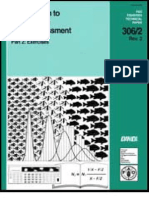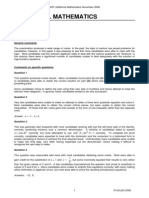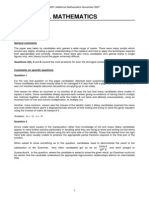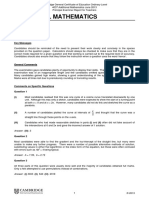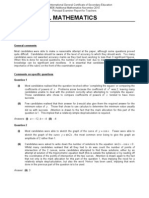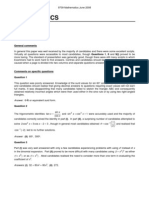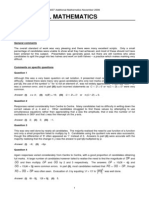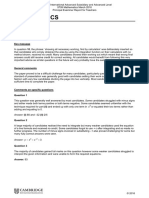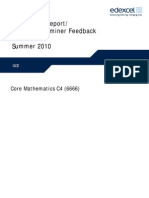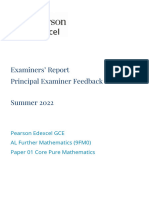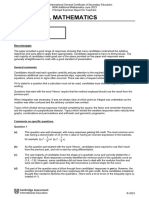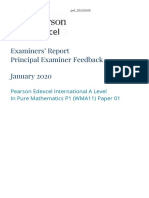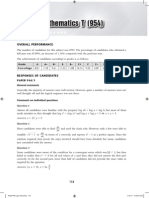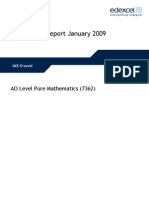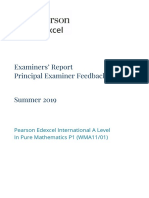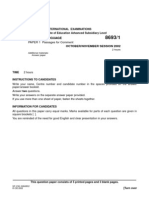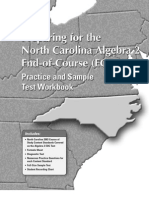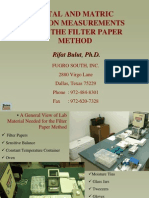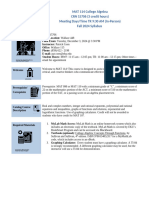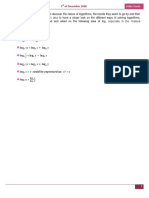Additional Mathematics: Paper 4037/11 Paper 11
Additional Mathematics: Paper 4037/11 Paper 11
Uploaded by
mstudy123456Copyright:
Available Formats
Additional Mathematics: Paper 4037/11 Paper 11
Additional Mathematics: Paper 4037/11 Paper 11
Uploaded by
mstudy123456Original Title
Copyright
Available Formats
Share this document
Did you find this document useful?
Is this content inappropriate?
Copyright:
Available Formats
Additional Mathematics: Paper 4037/11 Paper 11
Additional Mathematics: Paper 4037/11 Paper 11
Uploaded by
mstudy123456Copyright:
Available Formats
General Certificate of Education Ordinary Level
4037 Additional Mathematics June 2010
Principal Examiner Report for Teachers
UCLES 2010
ADDITIONAL MATHEMATICS
Paper 4037/11
Paper 11
General comments
The majority of candidates were able to make a reasonable attempt at the paper. Marks obtained covered
the whole range, with only a few, who were clearly unprepared for the paper, obtaining scores in single
figures.
Candidates should be reminded of the importance of showing all their working clearly, as the omission of
necessary working can lead to the loss of marks. Marks may also be awarded for correct working when the
final answer is incorrect.
Centres should note that, from June 2011, candidates will be required to answer on the question paper,
rather than in a separate answer booklet. New specimen papers have been produced and can be found on
the CIE Teacher Support site.
Comments on specific questions
Question 1
(i) Most candidates were able to convert the square root to a power. The need to use the chain rule
to differentiate was usually recognised.
(ii) The product rule was used by the majority of candidates, but some had difficulty with the differential
of x 2 sin , often missing out the negative sign and sometimes giving just 2 sin . Attempts at
simplification were often inaccurate,
2
4 sin x being common.
Answers: (i)
2
1
2
2
) 1 (
2
3
+ x
x
(ii) 2x cos 2x 2x
2
sin 2x
Question 2
(i) Most candidates were able to gain full marks in this part of the question, although a number of
candidates gave 45 as the coefficient of x
2
. A small minority left their answer in terms of
r
n
and
failed to complete their calculations.
(ii) There were many correct solutions to this part, most candidates appreciating the need for three
terms from the expansion. Those who wrote out the whole expansion to pick out the relevant terms
were more likely to make errors, as well as use up time.
Answers: (i) 1 + 18x + 135x
2
(ii) 76
Question 3
Most candidates used the discriminant to get to the critical values, but only a few went on to give the range of
values required. Weaker candidates expanded the expression and then attempted to solve it using the
quadratic formula.
Answers: k 2 and k 10
1
General Certificate of Education Ordinary Level
4037 Additional Mathematics June 2010
Principal Examiner Report for Teachers
UCLES 2010
Question 4
(a) Many candidates obtained the correct solution for part (i) but found (ii) and (iii) more difficult.
(b) Answers here were sometimes incorrectly given as inequalities, for example 9 x 14.
A common incorrect answer to (iii) was {0}.
Answers: (b)(i) {9, 10, 11, 12, 13, 14} (ii) {5, 6, 7, , 20} (iii)
Question 5
This question was attempted well by most candidates. There were many completely correct solutions. A few
candidates factorised the equation, but then stopped at that point, without solving it.
Answers:
3
1
or , 4 , 2 = x
Question 6
(i) This question was well done by most candidates, although
2
2
1
y x + was a common incorrect
answer.
(ii) Most candidates appreciated that this answer required the difference of two logarithms, although
some did not then realise that log
8
8 = 1.
(iii) This proved to be the most difficult part of the question. Many candidates managed to get to 6, but
the change of base was too difficult for some and a completely correct answer was only obtained
by the better candidates.
Answers: (i) y x 2
2
1
+ (ii) y 1 (iii) 6 + 3x
Question 7
(i) Many candidates calculated 3, but then failed to state the range.
(ii) Most realised that they needed to interchange x and y, although some answers were left in terms
of y rather than x. A number of candidates expanded the brackets prior to any other work, and
then tried to rearrange the resulting expression, often leading to answers in terms of both x and y.
(iii) Most candidates were able to apply the functions in the correct order to obtain an equation in x. Of
those who simplified this equation to a quadratic, a number failed to notice that 2.2 should be
rejected, as it is not in the domain. Those who chose the simpler method of taking a square root
often got one solution by taking only the positive square root, without justifying the rejection of the
other solution from the negative square root.
Answers: (i) f 3 (ii)
2
1 3
f
1
+
=
x
(iii) x = 1
Question 8
(a) There were many good solutions to this question. Of those candidates who did not gain full marks,
the most common error was to multiply, rather than add, the powers of 2 on the left hand side of
the equation.
2
General Certificate of Education Ordinary Level
4037 Additional Mathematics June 2010
Principal Examiner Report for Teachers
UCLES 2010
(b) (i) Most candidates could work out that 3 6 108 = , but surprisingly, in view of the next part, found
3
12
much more difficult.
(ii) The majority of candidates knew how to rationalise the denominator, and gained full marks.
Answers: (a) x = 5 (b)(i) 3 2 (ii) 11 5 5 +
Question 9
(a) (i) Most candidates were able to differentiate correctly, although 5 4e
x
was a common incorrect
answer.
(ii) This was usually well done, although some candidates substituted x = p in
x
y
d
d
, rather than x = 0.
(b) Candidates found this the most difficult part of the question, and could make little progress unless
they realised the need to find
x
A
d
d
from A = x
2
.
Answers: (a)(i) 5 + 4e
x
(ii) 9p (b)
12
1
Question 10
(i) Most candidates were able to obtain an equation in tanx and to solve it. Those who squared the
equation to get another equation in either sinx or cosx usually finished up with extra, invalid
solutions.
(ii) Most candidates used the correct trigonometrical identity to obtain an equation in sinx. A number
of them then chose to divide by sinx and so lost one of the solutions.
(iii) Although most candidates knew that
x
x
cos
1
sec = , a large number were unable to manipulate the
equation correctly to obtain
4
1
3
cos =
z
. Common errors were secz = 12 or 4
3
cos =
z
.
Answers: (i) 14.0, 194.0 (ii) 180, 199.5, 340.5 (iii) 3.95 radians
Question 11 EITHER
(i) Most candidates recognised the need to differentiate using the quotient rule, and to equate
x
y
d
d
with 0, and this was generally well done. Few, however, were able to find the exact
coordinates of the stationary point, and decimal answers were common.
(ii) Candidates who simplified
x
y
d
d
in part (i) found this question to be reasonably straightforward, but
those who failed to cancel by x found this second differentiation to be very difficult, often failing to
realise that there was a product within the numerator of their
x
y
d
d
.
3
General Certificate of Education Ordinary Level
4037 Additional Mathematics June 2010
Principal Examiner Report for Teachers
UCLES 2010
(iii) Most candidates knew how to determine the nature of a stationary point by considering the sign of
2
2
d
d
x
y
at that point.
Answers: (i)
e 2
1
, e
2
1
= = y x (ii)
4
ln 6 5
x
x +
(iii) Maximum
Question 11 OR
(i) There were few good solutions, many candidates being unable to integrate correctly. Answers
such as
+
2
sin 6
2
x were common, and the constant of integration was often omitted. Some
candidates found a straight line equation for the curve using the given derivative as the gradient.
(ii) Most candidates tried to solve 0
d
d
=
x
y
, but failed to find all three possible values of x.
(iii) Few candidates were able to get to the correct solution. Many were able to find a perpendicular
gradient, but used the coordinates given in part (i) to find the equation of the normal.
Answers: (i) 5
2
2 sin 3 +
+ =
x y (ii)
,
2
, 0 (iii) 39 . 5
6
1
+ = x y
4
General Certificate of Education Ordinary Level
4037 Additional Mathematics June 2010
Principal Examiner Report for Teachers
UCLES 2010
ADDITIONAL MATHEMATICS
Paper 4037/12
Paper 12
General comments
Most candidates were able to make a good attempt at the paper, showing a fair understanding of the
syllabus content. Most showed the ability to apply mathematical techniques both appropriately and correctly.
Candidates are reminded of the need to present their work clearly; this also means showing the relevant
steps involved in the solution of a problem, not merely writing down the answer. Too many candidates lost
marks by failing to show the methods involved in their solutions. Candidates are also reminded to work to
the appropriate degree of accuracy. Answers, if not exact, are to be to 3 significant figures which means
prior workings must be to a greater degree of accuracy. Again, too many candidates lost marks by not
working to this required level of accuracy.
Centres should note that, from June 2011, candidates will be required to answer on the question paper,
rather than in a separate answer booklet. New specimen papers have been produced and can be found on
the CIE Teacher Support site.
Comments on specific questions
Question 1
Most candidates realised that a quadratic equation in one variable was to be obtained. There were many
arithmetic errors which resulted in incorrect equations. However, most were able to make a correct attempt
to solve their quadratic equation, but there were some who lost the solution 0 = x .
Answer: ( )
2 ,
4
1
, 1 , 0
Question 2
Whilst most candidates made the appropriate substitutions there were again arithmetic errors which meant
that the required value of 8 = a
could not be found. Candidates are advised to check through their work
when this happens to try to identify errors.
Answer: a = 8, b = 13
Question 3
(i) Finding AB was usually done correctly. However, although most candidates found the magnitude
of AB there are still those who do not know how to find a unit vector.
(ii) Problems with this part usually involved a sign error between relevant vectors.
Answer: (i)
20
21
29
1
(ii)
35
46
5
General Certificate of Education Ordinary Level
4037 Additional Mathematics June 2010
Principal Examiner Report for Teachers
UCLES 2010
Question 4
(i) Most candidates realised that the straight line took the form of c x y + = sec 2
2
, having correctly
found the gradient. Errors occurred when it came to the calculation of +c with candidates
misunderstanding which values to substitute into their equation.
(ii) Correct solutions were in the minority. The question asked for the exact value of x cos . There
were many decimal answers and many candidates actually tried to solve their equation to find x.
Answer: (i) 4 . 6 sec 2
2
+ = x y (ii)
6
5
Question 5
If candidates did not realise that calculus was involved then they did not progress far. Most found the
coordinates of the point A and those that did attempt differentiation were usually able to obtain the required
gradient, the equation of the normal and hence make an attempt at the coordinates where the normal meets
the x-axis.
Answer:
0 ,
3
14
Question 6
(a) (i) Most candidates were able to do a reasonable sketch of the curve x y cos = , although some
attempts appeared to be more straight lines and V-shaped than was necessary. While many were
able to apply both the appropriate transformations to their curve, some were only able to apply one
of these transformations.
(ii) Only candidates with completely correct curves were able to obtain the mark for this part. Some
chose to try to solve the equation, misunderstanding the demands of the question.
(b) (i) There were few incorrect answers for this part.
(ii) Many candidates incorrectly gave an answer of 3, misunderstanding the nature of the question.
Answers: (a)(ii) 4 (b)(i) 5 (ii)
3
2
Question 7
(i) Candidates were usually able to produce a reasonable graph; however, many used awkward
scales which then caused errors in reading from their graph in the later part of the question. Most
graphs were drawn with the axes in the correct position.
(ii) Although candidates had been instructed as to what to plot, many failed to make the connection
between the gradient of their graph and the value of n. Of those that did, quite a few failed to
realise that the gradient was negative. Poor plotting and scales often led to inaccuracies for those
that did try to find the gradient.
Candidates had been asked to use their graph to find the value of n, but there were still those that
chose to use the original equation and make calculations from this and the original points. These
solutions did not score at all.
(iii) Many of those who failed to find n were able to use their graph effectively to find a value for p,
although many forgot that they had to use a power of ten in addition to the use of their graph.
Again poor plotting and scales led to inaccuracies that produced solutions that were outside the
acceptable range.
Answers: (ii) 32 . 1 42 . 1 n (iii) 32 25 p
6
General Certificate of Education Ordinary Level
4037 Additional Mathematics June 2010
Principal Examiner Report for Teachers
UCLES 2010
Question 8
(i) Apart from the odd arithmetic slip, most of the solutions offered were correct.
(ii) There were the occasional errors in either the determinant or the adjoint matrix, but most solutions
were correct.
(iii) The question was written to test the candidates knowledge of matrix algebra and it was hoped that
most candidates would realise that X = AB and all that would be required would be a
straightforward case of matrix multiplication. Whilst many candidates did solve the problem in this
way, others chose to find B
-1
and use this together with a matrix containing 4 unknown elements
and simultaneous equations to find X. Although this is a perfectly acceptable but longer method,
there were many arithmetic slips which caused candidates to lose marks. Others attempted
erroneously to try to divide 2 matrices thus showing a complete misunderstanding of the topic.
Answers: (i)
2 - 1
9 16
(ii)
4 1
3 2
5
1
(iii)
8 0
12 5
Question 9
(i) Although there were many correct solutions, some candidates had difficulty forming a correct
expression for the perimeter and were thus unable to obtain a correct value for the angle.
(ii) Most candidates used the correct formula for the area of a sector of a circle. Some candidates lost
marks as they omitted to find the correct areas to form a ratio, obtaining the answer 9:64 instead.
Many candidates lost marks by not giving their answer in the required form.
Answer: (i) 0.5 (ii) 9:55
Question 10
(i) Very few candidates obtained incorrect answers, choosing correctly to use combinations rather
than permutations.
(ii) Most solutions seen were correct. The use of permutations was rare.
(iii) Occasional solutions were seen where the candidate was attempting to choose from 7 and other
solutions did not consider all the cases required. However the great majority of solutions seen
were correct.
Answers: (i) 120 (ii) 36 (iii) 100
Question 11
This question was probably the most poorly done question on the paper, with some candidates not
attempting it.
(i) Too many candidates did not know how to deal with the logarithmic term in the equation.
3 ln 2 ln 4 + = t was a common error. Some candidates gave an inaccurate answer of 26.
(ii) The need for differentiation was realised by most candidates (apart from a few who insisted on
trying to use linear motion equations). Many candidates were unable to differentiate correctly,
often including logarithmic terms in their answers (usually from an incorrect attempt at
differentiating a product) or forgetting the factor of 12.
(iii) This part of the question was badly done in the same way as part (ii), with similar errors
compounding those already made. Occasionally candidates omitted the negative sign from their
answer although this was usually the result of poor differentiation.
Answers: (i) 25.8 (ii) 4.8 (iii) 1.92
7
General Certificate of Education Ordinary Level
4037 Additional Mathematics June 2010
Principal Examiner Report for Teachers
UCLES 2010
Question 12 EITHER
This was less popular than the OR option.
(i) Most candidates realised that they had to integrate and include an arbitrary constant in order to
show what was required. Some adopted an approach of verification but only went as far as
differentiating the given equation, not showing that the coordinates satisfied the given equation.
(ii) Correct attempts at solutions were common, but many candidates chose to give only one solution
to their equation. Those that chose to give their solutions in decimal form in radians often did not
give the required level of accuracy which then had a detrimental effect on later work.
(iii) The area of the rectangle was often forgotten, but most candidates were able to make a
reasonable attempt at integration to find the area under the curve. Some adopted an all in one
approach which usually tended to be more successful.
Answers: (i) 3 2 sin 4 + = x y (ii)
12
5
,
12
(iii) 1.37
Question 12 OR
(i) There were many correct solutions although there were candidates who forgot to include an
arbitrary constant. This then had a detrimental effect in the next part of the question. Other
candidates mistakenly assumed that the value of the arbitrary constant was 1 as the curve went
through the point (0, 1).
(ii) Most candidates were able to make a reasonable attempt at finding the coordinates of the turning
point, recognising that they already had the necessary derivative already given in the first part of
the question. Problems occurred when it came to the accuracy of the required coordinates. Too
many candidates did not give their answers to the required significant figures, 0.23 being the most
common solution. This then caused problems when calculating the y-coordinate using prematurely
approximated values. Exact values for the coordinates were acceptable.
(iii) Usually done well; most candidates were able to produce a correct method for determining the
nature of the turning point. Some, however, did not state the reason for their conclusion which was
an essential part of the method required.
(iv) Apart from those candidates who calculated the equation of the normal rather than the tangent, the
great majority of the solutions seen were correct.
Answers: (i) 1 12 e 2
3
= x y
x
(ii) ( ) 0.227 0.231, (iii) minimum point (iv)
0 ,
6
1
8
General Certificate of Education Ordinary Level
4037 Additional Mathematics June 2010
Principal Examiner Report for Teachers
UCLES 2010
ADDITIONAL MATHEMATICS
Paper 4037/21
Paper 21
General comments
Some candidates produced high quality work displaying wide ranging mathematical skills, with well
presented, clearly organised answers. Overall however, the performance was weak, with a substantial
number of candidates scoring fewer than 20 marks. The majority of candidates attempted the majority of
questions.
Candidates found that Questions 5, 6, and 8 were most straightforward, and most likely to yield full marks.
It was very common for a score of zero to be obtained on Question 10 and many candidates omitted this
question altogether. It was pleasing to see the almost universal improvement in the manipulation of
matrices. In Question 4(a) calculators were used too readily, the requirement of the question for exact
values being ignored. Question 7 saw the use of some long methods, especially when calculating the area
having found appropriate coordinates, with more efficient methods proving more successful.
Centres should note that, from June 2011, candidates will be required to answer on the question paper,
rather than in a separate answer booklet. New specimen papers have been produced and can be found on
the CIE Teacher Support site.
Comments on specific questions
Question 1
This question was not answered well, with many candidates failing to appreciate that the axes were labelled
2
x
y
and x
3
. Many candidates, whilst knowing they had to find the gradient and intercept, did not know what
to do afterwards. A common final answer was y = 2x + 15. Several of those who did manage to arrive at a
relation of the form c mx
x
y
+ =
3
2
then proceeded to spoil their answer by writing y = mx
6
+ cx
2
.
Answer: y = 2x
5
+ 15x
2
Question 2
Most candidates were able to gain some marks for this question but full marks were not often seen. Part (i)
was found to be the most straightforward although 8 was a not infrequent response. Candidates often got
one or other of parts (ii) and (iii) correct with the main errors involving multiplying factorials or leaving
answers incomplete using C or P notation.
Answers: (i) 40320 (ii) 56 (iii) 60
9
General Certificate of Education Ordinary Level
4037 Additional Mathematics June 2010
Principal Examiner Report for Teachers
UCLES 2010
Question 3
Although most candidates were able to obtain the required relation between b and a in part (i), this was often
not used in part (ii). Instead, it was common to see the remainders equated to zero and then simultaneous
equations solved for a and b. Others attempted to solve f(3) = 2f(2), or incorrectly 2f(3) = f(2), usually with no
reference to part (i) again.
Many candidates did not use the Remainder Theorem in either part but instead used the long division
method which proved less successful, as candidates often failed to reach a remainder in b and a only.
Answer: (i) 5 a
Question 4
(a) This question was not answered well by the majority of candidates. Almost none appreciated the
significance of the phrase exact values so that approximate decimals appeared for both answers.
Those who made attempts at applying Pythagoras theorem were often spoilt by omitting brackets
and writing p
2
+ 2p
2
= 1.
(b) While some candidates proved the trigonometric identities with relative ease the proof seldom
gained full marks, with dubious algebra and inaccurate identities often evident. Frequently the only
mark gained was for removing the brackets correctly. Many attempts lasted for several pages, the
preferred approach usually being to work with sines and cosines. Even the very best candidates
often lost marks on this question.
Answers: (i)
5
1
= p , cosecx 5 =
Question 5
This question was well answered by a large number of candidates, with many achieving full marks. The
overall method for solution was seen as straightforward by the majority of candidates. The differentiation was
generally successful, but solving the equation 2 16x
1.5
= 0 was often done incorrectly. Many candidates
resorted to using logarithms and although this was occasionally and laboriously completed successfully, it
generally led to poor or muddled algebra.
Answer: (4,144)
Question 6
This was a routine question for almost all candidates, and a good source of marks for many. Candidates
demonstrated secure understanding of solving quadratic and linear simultaneous equations. Most were able
to gain some marks for this question, although weaker candidates invariably arrived at 4x
2
+ 20x + 17 = 0 or
similar, instead of the correct quadratic equation for x, the negative y
2
mainly causing their undoing.
Answer: 32 or 2 4 or 5.66
10
General Certificate of Education Ordinary Level
4037 Additional Mathematics June 2010
Principal Examiner Report for Teachers
UCLES 2010
Question 7
Although several methods were suitable, it was essential to first find the coordinates of D. The bulk of the
work should have taken place in doing this but some candidates attempted to find the area without finding it,
gaining no credit as a result. However, most candidates were able to obtain some credit, usually for
identifying the gradient of BC and its perpendicular. Not all saw the importance of the midpoint however,
giving the equation of an incorrect bisector.
The latter part of this question frequently covered several sides of paper, most of which gained no marks at
all and involved finding a variety of lengths and angles. Many candidates made the false assumption that AB
and BC were perpendicular, which meant that they tried to calculate the area of a trapezium. Relatively few
candidates arrived at the correct area of 15 square units. There were some elegant solutions involving the
difference of two triangles but by far the simplest and most efficient solution involved using the array method
for calculating an area.
Answer: 15
Question 8
Almost all candidates were able to gain some marks on this matrix question. However, a large number of
careless arithmetical slips were made and there were many candidates who thought that it was not possible
to calculate the product BA asked for in part (a)(iii). The inverse of matrix C was usually found correctly, but
the product C
1
D was often attempted in part (b)(ii). It was pleasing to see so many candidates using the
inverse matrix, rather than simultaneous equations, even though they had not been instructed to do so.
Answers: (a)(i)
8 10 2
14 6 4
(ii)
44 64
8 12
(iii)
80 6 22
18 1 5
(b)(i)
2 7
1 6
5
1
C
1
(ii)
0 5
2 3
5
1
Question 9
Performance overall on this question was disappointing and full marks were seldom awarded. Those
candidates who knew the basic calculus commonly obtained partial credit from obtaining the correct forms
for the integral in part (i) and the derivative in part (ii). However, in part (i) the need to find the time at which
the particle next comes to rest was almost universally ignored and very few candidates were able to obtain
the value
2
= t . Very few candidates remembered the constant of integration in part (i). In fact it was
sometimes assumed that 2cos2t was sufficient for an answer. Very few remembered to use radian mode
on their calculator in part (ii).
The very weakest candidates used no calculus, and made attempts using equations of constant speed or
constant acceleration.
Answers: (i) 4 (ii) 7.68
Question 10
Only a small proportion of candidates managed to secure full marks on this question. Many candidates were
able to arrive at the given answer of 25 km in the first part, but there were very few attempts at the second
part seen and many omitted the question altogether. Some of those who had successfully completed part (i)
seemed to think that the 7 and 24 which had been used somehow had to be used in part (ii). Of those who
did work their way through part (ii) and successfully solved the quadratic equation many omitted to calculate
the length of time as required and gave a final answer of t = 2 or 6 or 2 < t < 6. There was also confusion in
some minds with what appeared to be matrix methods applied with large values appearing from some form
of multiplication.
Answer: (ii) 4
11
General Certificate of Education Ordinary Level
4037 Additional Mathematics June 2010
Principal Examiner Report for Teachers
UCLES 2010
Question 11 EITHER
Some good attempts at this question were seen, although invariably some candidates used the obtuse angle
where the reflex angle was required. It was pleasing to see that there was hardly any confusion between the
perimeter and area formulae, and that in part (i) very few included the perimeter of the whole triangle in their
calculation. Errors were often made in the misuse of , either including it in formulae incorrectly or overusing
it in other cases. Another error made by several candidates was to assume triangle OAD could be split into
two right-angled triangles by subdividing 0.8 in a number of arbitrary ways. In part (ii) marks were
sometimes lost by not working to sufficient accuracy. This particularly applied to those scripts where all the
angles in radians had been converted to slightly inaccurate angles in degrees.
Answers: (i) 45.8 (ii) 89.0
Question 11 OR
This option was reasonably well done, with fairly routine marks available from finding the derivative in part (i)
and for integrating to find the area under the curve in part (ii). In part (i), many correctly found the equation
of the tangent then solved simultaneously with the equation of the curve, and solved the resulting cubic for
all three roots, realising that (x 1) was a factor. In part (ii) the most common approach was to subtract the
area under the curve from a trapezium, rather than using the difference of the line and curve. In general,
errors here tended to be errors of detail rather than principle, though some candidates seem to have
considered the solution to be complete having found the area under the curve.
Answer: (ii) 6.75
12
General Certificate of Education Ordinary Level
4037 Additional Mathematics June 2010
Principal Examiner Report for Teachers
UCLES 2010
ADDITIONAL MATHEMATICS
Paper 4037/22
Paper 22
General comments
There were many excellent, well presented scripts seen. These demonstrated a clear understanding of the
principles involved in the topics examined. There were a considerable number of candidates who scored full
marks, but a similar number who failed to score full marks because of careless reading of the paper.
Examples of this were a failure to show the coordinates of the points where the graph meets the axes in
Question 7, a failure to give answers correct to 2 decimal places in Question 11 part (i) and using the form
c b x a + +
2
) ( rather than c b ax + +
2
) ( in Question 12 OR part (ii).
Centres should note that, from June 2011, candidates will be required to answer on the question paper,
rather than in a separate answer booklet. New specimen papers have been produced and can be found on
the CIE Teacher Support site.
Comments on specific questions
Question 1
A very straightforward start for most candidates, with most picking up at least the first two marks. The final
term caused the major problems with a variety of answers offered by the weaker candidates. A small but
significant number of candidates attempted to combine the three terms before integration and found it difficult
to proceed. Others tried to combine the terms after integration and again got into difficulties, but this time
they did not lose marks already awarded for correct integration.
Answer: ) (
2
1
2
5
2
2
c
x
x
x +
+ +
Question 2
The success rate for the whole question was mixed. The diagram in part (a) was reasonably well done,
although quite a number of candidates had little idea of how to handle Venn diagrams. The most frequent
error was to leave A C unshaded. A very small number decided to include (A U B U C).
The majority of candidates were able to express the region correctly in part (b) although quite a number gave
an expression that was far more complex than necessary. The simplest form was X U Y but many gave this
incorrectly as X Y. Some candidates included the Universal set e.g. U (X UY) making it completely
wrong.
The success or otherwise in part (c) did not seem to be affected by whether the candidates set up a formal
equation or not. Most of the better candidates were able to correctly calculate 6 without showing any
working. Candidates who did attempt to set up an equation frequently forgot to include the variable that they
were trying to find, x, after including 16 x and 18 x. Also frequently forgotten was the 2.
Answers: (b) X U Y , (X Y ) , X U (X Y) or equivalent (c) 6
13
General Certificate of Education Ordinary Level
4037 Additional Mathematics June 2010
Principal Examiner Report for Teachers
UCLES 2010
Question 3
This question was generally well done with many candidates scoring full marks. Weaker candidates often
reached 4r, but did not know how to proceed further.
Answer: 144
1 3
s cm
Question 4
Part (i) was done less well than part (ii). Most candidates were able to set up the correct expression for tan
but were unable to rationalise correctly. Many simply inverted the fraction to give
16
6 7
. Others showed that
they knew what to attempt but failed completely to handle the arithmetic.
Part (ii) was very well done with the vast majority gaining full marks. Almost all candidates were able to
correctly apply Pythagoras and almost all of these went on to correctly arrive at 275 . At this stage
however, a number of candidates were unable to deal with the surds.
Answers: (i)
21
6 8
(ii) 11 5
Question 5
Full marks were scored by the majority of candidates. Most found the first factor from the remainder theorem
and then went on to find the quadratic factor, usually by synthetic division or algebraic division, and then
factorised this factor. A few found all 3 factors using the remainder theorem. One mark was often lost
because one or more roots were not listed, with candidates just giving the factors. Very few candidates
scored less than 5 marks; these tended to be the lowest achievers overall.
Answer: 3 and
2
1
and 2
Question 6
In general good candidates scored very well on this question but weaker candidates made little or no
progress.
Almost all candidates were able to write down the equation for the area as A = xy, but many were unable to
proceed further because they were unable to link it with the equation for the line y = 12 2x. Being unable to
write A in terms of x, made it virtually impossible for candidates to progress further. Those who were able to
set up the correct expression for A generally went on to obtain 7 or 8 marks. Quite a number failed to give
the value for A required in part (iii) and a small number failed to determine the nature of the stationary value.
Answers: (i)
2
2 12 x x A = (ii) 3 (iii) 18, maximum
Question 7
This was another high scoring question, with most candidates scoring 6 or 7 marks. Most commonly, a mark
was lost on the graph for not clearly labelling where the line cut the y-axis. Most candidates were successful
in drawing the graph of the modulus function correctly, although a few joined the two straight lines with a
small curve. Part (iii) was relatively well answered with many candidates working through the algebraic
equation to find the values of x. Those candidates who read from the graph did not always score well as
their diagram was only a sketch and therefore not accurate.
Answer (iii) 1.5 and 3.75
14
General Certificate of Education Ordinary Level
4037 Additional Mathematics June 2010
Principal Examiner Report for Teachers
UCLES 2010
Question 8
On the whole, most candidates scored full marks in part (i) with only minor mistakes being seen by
candidates who did not. There were mixed results in part (ii), with many candidates not fully understanding
how to obtain a coefficient of x from a series. Candidates who wrote out the series were able to deduce the
correct coefficient with only a few losing marks at the calculation stage.
Part (iii) proved problematic for weaker candidates, some of whom wrote out the series but did not indicate
the correct term. Some stronger candidates realised that they needed to find r from
n
C
r
finding that r = 6.
However some candidates who had correctly found r = 6, then merely stated that the independent term was
the seventh term but did not perform the required calculation.
Answers: (i)
3 2
945 189 21 1 x x x + (ii) 4375 (iii) 5376
Question 9
Most candidates realised that they were required to differentiate using the product or quotient rule in part (i)
but only the better candidates were able to make solid progress through the whole question. Weaker
candidates often mixed up the two methods, usually writing it in the form for product rule and applying the
quotient rule, which was sometimes quoted incorrectly. Handling the indices was also a significant problem
for many. Having said that, a great many candidates did collect the first three marks for getting the derivative
in an unsimplified form, but arranging it into the form required proved beyond many. The algebraic
manipulation was frequently of doubtful accuracy but k = 2 was the most popular outcome whether justified
or not. The able candidates who realised the link between the two parts had little difficulty arriving at the
correct answer in part (ii) although a small number chose to multiply their integral by 2 rather than to divide.
Weaker candidates attempted to integrate the expression as given and got themselves into great difficulties.
Answers: (i) k = 2 (ii)
16
9
Question 10
A significant number of candidates were not confident in handling logarithms or indeed powers. However,
the use of a calculator enabled many to answer part (b). This was an easy question for those who did know
the laws of logarithms.
Candidates with a complete understanding of log theory had little difficulty in achieving the correct answer in
part (i) from 2logX log Y. Many candidates, however, lacked this understanding and seemed to assume
that X = 6 and Y = 4 to substitute into the original expression to give log (36 4) and gave 9 as the answer.
A smaller number showed a partial understanding to start with log(2X Y) which led to log(12 4) = log 3.
Again in (ii) the many candidates who understood what to do had little difficulty in achieving the correct
answer. A significant number rewrote log
Y
(X) as (log Y log X) rather than (log X log Y). Others realised
that in logarithm theory divide meant subtract and gave an answer of 6 4 = 2.
In part (iii), good candidates had little difficulty in obtaining the correct answer. Weaker candidates showed
very little understanding of the theory of indices and consequently rarely scored any marks. A significant
number of candidates calculated a value for z as 6.585 and then raised 2 to this power. If performed
accurately this did lead to 96, however answers such as 95.7 were very common; these answers lost 1 mark.
In the final part most candidates started to break down 512 into multiples of 2 or 4. A great many arrived at
2 2
4.5
or 4
4.5
but the 512 was a complication that defeated the vast majority and they were unable to
translate this into the required form with mixed answers such as 2 4
2
being common.
Answers: (a)(i) 8 (ii) 1.5 (b) 96 (c)
4
9
4
15
General Certificate of Education Ordinary Level
4037 Additional Mathematics June 2010
Principal Examiner Report for Teachers
UCLES 2010
Question 11
There was a range of marks in part (a) although a number of candidates did not give the answer to 2 decimal
places and so lost a mark. Quite a few did not find the second solution at all or did not find it correctly. A few
found the solutions in degrees. There were quite a lot of candidates scoring full marks in part (b). Most
earned a mark for knowing how to deal with cot y and cosec y, and went on to express their equation in cos y.
In rearranging the equation some lost the factor of 6 or a minus sign. Others introduced a factor of sin y and
ended up with extra solutions. Where the equation was correct, most went on to get all 4 solutions although
sometimes marks were lost for incorrect rounding. A few found solutions in the wrong quadrants e.g. 60
and 300.
Answers: (a) 0.85 and 2.29 (b) 48.2, 120, 240 and 311.8
Question 12 EITHER
This question on the whole was well answered with candidates substituting f(x)=3 to obtain the correct
quadratic. Attempting to factorise the quadratic proved problematic for some candidates who were unable to
find that k = 4 and 12, others found the correct values for k but did not identify the correct range of values.
There were a minority who ignored the 3 and consequently found values of 0 and 16 for k.
In part (ii) many candidates lost marks by not reading the question which stated that the answer needed to
be in the form (ax+b)+c; a final answer of
4
15
4
5
4
2
+
+ x was written by many candidates, thus loosing
them marks. In part (iii) many candidates scored full marks, despite losing marks in part (ii), with only a
minority losing marks by again not reading the question which asked for the minimum to be stated. Those
who just gave the coordinates of the turning point without identifying which was the least value of f(x) were
penalised.
Answers: (i) 4 < k < 12 (ii) a = 2, b = 2.5 and c = 3.75 (iii) 3.75 at x = 1.25
Question 12 OR
There were very few correct answers to part (i), even from good candidates. Mostly they had little idea how
to start and many simply left this part blank. Part (ii), however, was very well done. Wrong answers were
rare and, generally, only from the very weakest of candidates. Part (iii) was very well answered by most
candidates. There was an occasional error in calculating 10 ) 15 (
1
=
g and a small number of candidates
correctly achieved the correct expression for 26 20 4
2
+ x x but divided by 2 to give 13 10 2
2
+ x x before
putting it equal to 10. This obviously led to an incorrect equation that needed the use of the quadratic
formula and therefore an incorrect solution. There were very few correct graphs seen in the last part. Quite
a number of candidates showed the right idea but restricted the graph to the first quadrant.
Answers: (i) 1 f (ii) 15 (iii) 1 and 4
16
You might also like
- Regents Exams and Answers Geometry Revised EditionFrom EverandRegents Exams and Answers Geometry Revised EditionNo ratings yet
- Introduction To Tropical Fish Stock Assessment Part 2Document116 pagesIntroduction To Tropical Fish Stock Assessment Part 2George Ataher86% (7)
- Additional Mathematics: Paper 4037/11 Paper 11Document18 pagesAdditional Mathematics: Paper 4037/11 Paper 11mstudy123456No ratings yet
- Additional Mathematics: Paper 4037/11 Paper 11Document18 pagesAdditional Mathematics: Paper 4037/11 Paper 11BobsheikhNo ratings yet
- Additional MathematicsDocument22 pagesAdditional MathematicsAhmad KhanNo ratings yet
- Additional Mathematics: Paper 4037/01 Paper 1Document8 pagesAdditional Mathematics: Paper 4037/01 Paper 1mstudy123456No ratings yet
- Additional Mathematics: Answer: - 25 + 18Document10 pagesAdditional Mathematics: Answer: - 25 + 18mstudy123456No ratings yet
- Additional Mathematics: Paper 4037/01 Paper 1Document8 pagesAdditional Mathematics: Paper 4037/01 Paper 1mstudy123456No ratings yet
- Additional Mathematics: Paper 4037/11 Paper 11Document19 pagesAdditional Mathematics: Paper 4037/11 Paper 11sureshthevanNo ratings yet
- Additional Mathematics: Paper 0606/01 Paper 1Document8 pagesAdditional Mathematics: Paper 0606/01 Paper 1samchansa65No ratings yet
- 2002 HSC Notes From The Marking Centre MathematicsDocument33 pages2002 HSC Notes From The Marking Centre MathematicsYe ZhangNo ratings yet
- Additional Mathematics: Paper 4037/11 Paper 11Document19 pagesAdditional Mathematics: Paper 4037/11 Paper 11Sherlock Wesley ConanNo ratings yet
- Additional Mathematics: Paper 4037/01 Paper 1Document9 pagesAdditional Mathematics: Paper 4037/01 Paper 1mstudy123456No ratings yet
- Additional Mathematics: Paper 4037/01 Paper 1Document8 pagesAdditional Mathematics: Paper 4037/01 Paper 1mstudy123456No ratings yet
- Additional Mathematics: Paper 0606/11 Paper 11Document28 pagesAdditional Mathematics: Paper 0606/11 Paper 11Ahad JowaheerNo ratings yet
- 0606 Summer21 ErDocument26 pages0606 Summer21 ErSaikit TamNo ratings yet
- Mathematics: Paper 9709/01 Paper 1Document19 pagesMathematics: Paper 9709/01 Paper 1Iqra JawedNo ratings yet
- Additional Mathematics: Paper 4037/12 Paper 12Document14 pagesAdditional Mathematics: Paper 4037/12 Paper 12Wakif Khan PrantoNo ratings yet
- 9709 Mathematics June 2008Document19 pages9709 Mathematics June 2008Hubbak KhanNo ratings yet
- Additional Mathematics: Paper 4037/11 Paper 11Document29 pagesAdditional Mathematics: Paper 4037/11 Paper 11Waqar AhmedNo ratings yet
- Zimbabwe School Examinations Council (Zimsec) : Zimbabwe General Certificate of Education (ZGCE) Advanced LevelDocument16 pagesZimbabwe School Examinations Council (Zimsec) : Zimbabwe General Certificate of Education (ZGCE) Advanced LevelNigel ShambokoNo ratings yet
- June 2017 Examiner ReportDocument33 pagesJune 2017 Examiner ReportMohd ZawawiNo ratings yet
- Mathematics: Paper 9709/11 Paper 11 Key MessagesDocument59 pagesMathematics: Paper 9709/11 Paper 11 Key MessagesAditiNo ratings yet
- Additional MathematicsDocument30 pagesAdditional MathematicsMazita Mohd YassinNo ratings yet
- Subject Report June 2004-2Document6 pagesSubject Report June 2004-2will bellNo ratings yet
- Additional Mathematics: Paper 0606/11 Paper 11Document28 pagesAdditional Mathematics: Paper 0606/11 Paper 11Saikit TamNo ratings yet
- Additional Mathematics: Paper 4037/01 Paper 1Document9 pagesAdditional Mathematics: Paper 4037/01 Paper 1mstudy123456No ratings yet
- Paper 9709/12 Pure MathematicsDocument20 pagesPaper 9709/12 Pure MathematicsNadeem AhmadNo ratings yet
- STEP 2 2021 Examiner's Report and Mark SchemeDocument34 pagesSTEP 2 2021 Examiner's Report and Mark SchemeJiang HNo ratings yet
- Additional Mathematics: Paper 4037/01 Paper 1Document9 pagesAdditional Mathematics: Paper 4037/01 Paper 1mstudy123456No ratings yet
- 9MA0 02 Pef 20211216Document13 pages9MA0 02 Pef 20211216Fungi ChlorophyllNo ratings yet
- Additional Mathematics: Paper 0606/12 Paper 12Document10 pagesAdditional Mathematics: Paper 0606/12 Paper 12Elm TutchNo ratings yet
- Examinerreport Unit1 (WMA11) October2020Document8 pagesExaminerreport Unit1 (WMA11) October2020Mohammed Al RaeesiNo ratings yet
- Mathematical Studies: Mathematics Learning AreaDocument8 pagesMathematical Studies: Mathematics Learning AreaBobNo ratings yet
- Examiners' Report January 2008: GCE Mathematics (8371/8373,9371/9373)Document44 pagesExaminers' Report January 2008: GCE Mathematics (8371/8373,9371/9373)Bilal MalikNo ratings yet
- Examiners' Report/ Principal Examiner Feedback January 2012: GCE Core Mathematics C4 (6666) Paper 1Document12 pagesExaminers' Report/ Principal Examiner Feedback January 2012: GCE Core Mathematics C4 (6666) Paper 1theamnaNo ratings yet
- P2 Jan 2020 ERDocument13 pagesP2 Jan 2020 ERIshy HereNo ratings yet
- ER - 2020 A-Level Maths Paper 2Document8 pagesER - 2020 A-Level Maths Paper 2woodyyafaiNo ratings yet
- Examiner's Report June 2011: Additional MathematicsDocument7 pagesExaminer's Report June 2011: Additional MathematicsJon HadleyNo ratings yet
- 2010 January Examiners Report Core Mathematics C4 (6666)Document8 pages2010 January Examiners Report Core Mathematics C4 (6666)gerikaalhuNo ratings yet
- Examiners' Report/ Principal Examiner Feedback Summer 2010: Core Mathematics C4 (6666)Document12 pagesExaminers' Report/ Principal Examiner Feedback Summer 2010: Core Mathematics C4 (6666)alevelscienceNo ratings yet
- Examinerreport ASPaper1 June2018Document10 pagesExaminerreport ASPaper1 June2018j.smalley108No ratings yet
- Additional Mathematics: Paper 0606/11 Paper 11Document21 pagesAdditional Mathematics: Paper 0606/11 Paper 11leena_louisNo ratings yet
- Additional Mathematics........................................................................................... 2Document8 pagesAdditional Mathematics........................................................................................... 2Wong Kah Kei JoyceNo ratings yet
- 2004 HSC Notes From The Marking Centre Mathematics Extension 1Document27 pages2004 HSC Notes From The Marking Centre Mathematics Extension 1Owen TongNo ratings yet
- 9FM0-01 June 22 Examiners' ReportDocument12 pages9FM0-01 June 22 Examiners' ReportscribdNo ratings yet
- Additional Mathematics: Paper 0606/11 Paper 11Document29 pagesAdditional Mathematics: Paper 0606/11 Paper 11muhammadwaiztariq6440No ratings yet
- P1 Jan 2020 ERDocument11 pagesP1 Jan 2020 ERIshy HereNo ratings yet
- STEP 2 2020 Examiner's Report and Worked SolutionsDocument34 pagesSTEP 2 2020 Examiner's Report and Worked Solutionstony dooNo ratings yet
- Mathematics Syllabus DDocument21 pagesMathematics Syllabus DShay Yee ChinNo ratings yet
- 4mb0 02 Pef 20110824 Mark Scheme-may-2011-O-levelDocument9 pages4mb0 02 Pef 20110824 Mark Scheme-may-2011-O-levelMrinal Kanti BaroiNo ratings yet
- Examiners' Report/ Principal Examiner Feedback January 2012Document10 pagesExaminers' Report/ Principal Examiner Feedback January 2012Regy_101No ratings yet
- 4024 s11 ErDocument23 pages4024 s11 Ermstudy123456No ratings yet
- Laporan Peperiksaan Dan Jawapan STPM 2010 MT954 PDFDocument5 pagesLaporan Peperiksaan Dan Jawapan STPM 2010 MT954 PDFsound05No ratings yet
- Examinerreport Paper2 June2012Document10 pagesExaminerreport Paper2 June2012cinna morollNo ratings yet
- Paper 9709/12 Pure MathematicsDocument21 pagesPaper 9709/12 Pure Mathematicssutirman.chaiNo ratings yet
- 7362 GCE AO Level Pure Mathematics Rep 20090312Document16 pages7362 GCE AO Level Pure Mathematics Rep 20090312rizwan_ashraf_16No ratings yet
- Examiner's Report Principal Examiner Feedback: Pearson Edexcel International A Level in Pure Mathematics P2 (WMA12/01)Document10 pagesExaminer's Report Principal Examiner Feedback: Pearson Edexcel International A Level in Pure Mathematics P2 (WMA12/01)Ishy HereNo ratings yet
- P1 June 2019 ERDocument7 pagesP1 June 2019 ERIshy HereNo ratings yet
- 8MA0 - 01 Pure Mathematics 1 ERDocument11 pages8MA0 - 01 Pure Mathematics 1 ERAmi SueNo ratings yet
- 0654 w04 Ms 6Document6 pages0654 w04 Ms 6mstudy123456No ratings yet
- 0547 s06 TN 3Document20 pages0547 s06 TN 3mstudy123456No ratings yet
- Literature (English) : International General Certificate of Secondary EducationDocument1 pageLiterature (English) : International General Certificate of Secondary Educationmstudy123456No ratings yet
- 9701 s06 Ms 4Document5 pages9701 s06 Ms 4Kenzy99No ratings yet
- Frequently Asked Questions: A/AS Level Sociology (9699)Document1 pageFrequently Asked Questions: A/AS Level Sociology (9699)mstudy123456No ratings yet
- 0486 w09 QP 4Document36 pages0486 w09 QP 4mstudy123456No ratings yet
- 9694 w10 QP 23Document8 pages9694 w10 QP 23mstudy123456No ratings yet
- 9694 s11 QP 21Document8 pages9694 s11 QP 21mstudy123456No ratings yet
- University of Cambridge International Examinations General Certificate of Education Advanced LevelDocument2 pagesUniversity of Cambridge International Examinations General Certificate of Education Advanced Levelmstudy123456No ratings yet
- 8780 w12 QP 1Document16 pages8780 w12 QP 1mstudy123456No ratings yet
- 8693 English Language: MARK SCHEME For The October/November 2009 Question Paper For The Guidance of TeachersDocument4 pages8693 English Language: MARK SCHEME For The October/November 2009 Question Paper For The Guidance of Teachersmstudy123456No ratings yet
- English Language: PAPER 1 Passages For CommentDocument8 pagesEnglish Language: PAPER 1 Passages For Commentmstudy123456No ratings yet
- 8679 w04 ErDocument4 pages8679 w04 Ermstudy123456No ratings yet
- First Language Spanish: Paper 8665/22 Reading and WritingDocument6 pagesFirst Language Spanish: Paper 8665/22 Reading and Writingmstudy123456No ratings yet
- 9719 SPANISH 8685 Spanish Language: MARK SCHEME For The May/June 2009 Question Paper For The Guidance of TeachersDocument3 pages9719 SPANISH 8685 Spanish Language: MARK SCHEME For The May/June 2009 Question Paper For The Guidance of Teachersmstudy123456No ratings yet
- 3-Case Study - XII - O.P. GUPTADocument19 pages3-Case Study - XII - O.P. GUPTAsbprem2007No ratings yet
- Euler Notes 99Document160 pagesEuler Notes 99lidcc87No ratings yet
- Cuet Leet Syllabus-1Document37 pagesCuet Leet Syllabus-1akash9918833567No ratings yet
- EstDocument14 pagesEstBear ZOobearNo ratings yet
- Harmonic Analysis of A Cantilever BeamDocument12 pagesHarmonic Analysis of A Cantilever Beamakroma123No ratings yet
- Algebra2 Glenco EOCDocument62 pagesAlgebra2 Glenco EOCDeborah LeeNo ratings yet
- 05 DB MathDocument23 pages05 DB MathKopano Malombo100% (2)
- MIR - LML - Markushevich A. I. - Areas and LogarithmsDocument76 pagesMIR - LML - Markushevich A. I. - Areas and Logarithmsavast2008100% (6)
- Total and Matric Suction Measurements With The Filter Paper MethodDocument46 pagesTotal and Matric Suction Measurements With The Filter Paper MethodmchetiaNo ratings yet
- En 13640 2002Document11 pagesEn 13640 2002hithamextrastepNo ratings yet
- BoschettiDocument6 pagesBoschettifreetime8334No ratings yet
- Manual Calculadora Casio fx100S PDFDocument48 pagesManual Calculadora Casio fx100S PDFAgapornisNo ratings yet
- Finance Last Push-1Document35 pagesFinance Last Push-1lulamangwenya67No ratings yet
- BTYD WalkthroughDocument39 pagesBTYD WalkthroughpauloyyjNo ratings yet
- Mat 102Document5 pagesMat 102bexilexi94No ratings yet
- CH-2 - Lecture 3 - Indices - Logarithmsand Exponential - FunctionsDocument26 pagesCH-2 - Lecture 3 - Indices - Logarithmsand Exponential - FunctionsHedi RiahiNo ratings yet
- Wideband Air-Ground Channel Model For A Regional Airport Environment PDFDocument16 pagesWideband Air-Ground Channel Model For A Regional Airport Environment PDFAilton OliveiraNo ratings yet
- Genmath q1 Mod28 Solvingreal-Lifeproblemsinvolvingexponentialfunctionsequationsandinequalities v2Document24 pagesGenmath q1 Mod28 Solvingreal-Lifeproblemsinvolvingexponentialfunctionsequationsandinequalities v2DaphneeNo ratings yet
- Physics Practical Record Book Grade 12Document110 pagesPhysics Practical Record Book Grade 12shashankNo ratings yet
- MAT114 Fall2024 15706Document9 pagesMAT114 Fall2024 15706jmbronson1No ratings yet
- Folland 6Document13 pagesFolland 6epourhadiNo ratings yet
- Analysis and Approaches 1 Page Formula Sheet V1.3Document1 pageAnalysis and Approaches 1 Page Formula Sheet V1.3AyaNo ratings yet
- CSE-206 - Lab Report - 01 PDFDocument6 pagesCSE-206 - Lab Report - 01 PDFSK Ashraful IslamNo ratings yet
- CS210 Lecture 5 Proof of Correctness Solving Local Minima in GridDocument24 pagesCS210 Lecture 5 Proof of Correctness Solving Local Minima in GridSahil BansalNo ratings yet
- g11 PDFDocument2 pagesg11 PDFGENELYN BAGUIONo ratings yet
- Pressure Transient Testing of Gas WellsDocument8 pagesPressure Transient Testing of Gas WellsLuis Alfredo Romero AguileraNo ratings yet
- Math IADocument31 pagesMath IADev ShahNo ratings yet
- Phyllotaxis As A Dynamical Self Organizing Process Part I: The Spiral Modes Resulting From Time-Periodic IterationsDocument20 pagesPhyllotaxis As A Dynamical Self Organizing Process Part I: The Spiral Modes Resulting From Time-Periodic Iterationszxhym100% (1)
- 06 BinsearchDocument15 pages06 BinsearchRajdip PalNo ratings yet

